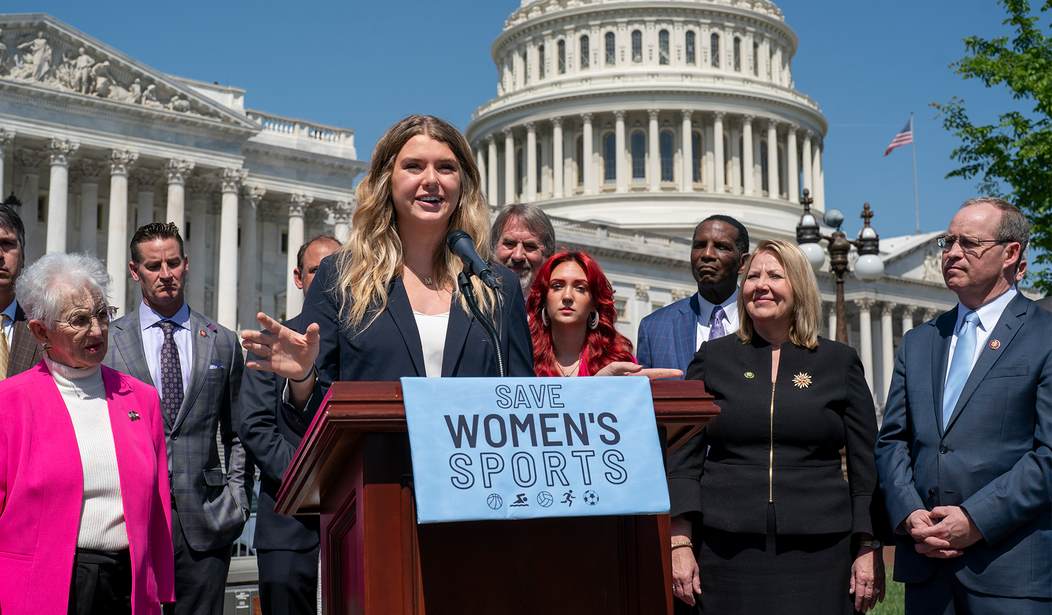The issue of males in female spaces has become a polarizing topic this election cycle, with lawmakers divided among party lines and candidates split over how to balance the accommodation of trans-identifying individuals and the protection of women’s rights to safety, privacy, and equal opportunities—particularly in areas such as female sports and spaces like locker rooms, restrooms, domestic violence shelters, rape crisis centers, women’s prisons, and other traditionally sex-segregated areas.
However, 70% of Americans have strong views on the issue and view participation of trans-identifying males in female sports more through a lens of competitive fairness than civil rights. As a result, a larger majority of Americans say male athletes who identify as women should only be allowed to compete in sports teams that conform to their sex at birth.
The enactment of Title IX in 1972—which prohibits discrimination on the basis of sex in any school or education program that receives federal funds—is largely responsible for the significant growth of women’s sports over the last 50 years. However, the participation gap for girls in sports is still significant. Girls generally play sports less than boys at all age levels. And Latina girls play fewer sports than other girls at all age levels. According to a study from the U.S. Centers for Disease Control and Prevention, 55% of high school girls played on at least one sports team compared to only 48% of Hispanic girls. There are many reasons for this phenomenon, including ideological beliefs about the value of sports, socioeconomic factors, language barriers, culture, and perceived gender norms.
At the college level, Hispanic student-athletes across the National Collegiate Athletic Association (NCAA) reached 34,526, a 70% increase in participation over the past decade. However, among minority students enrolled in bachelor’s degree programs, African American or Black students receive a greater number of athletic scholarships (22.8% in 2007-2008) as compared to other minority groups of students including Asian and Hispanic students. Asian students received the lowest number of athletic scholarships, 0.1% in 2007-2008.
Recommended
Despite recent progress in balancing the distribution of athletic scholarships, men still receive a disproportionately higher number of scholarships compared to women. In 2007-2008, 1.6% of male athletes were awarded scholarships, compared to 1.1% of female athletes. At the current rate of progress, it could take up to 17 years before men and women receive athletic scholarships at an equal rate!
Numerous scientific studies show that females have little chance of winning against male competitors. The largest performance gap is seen in the area of strength and speed. Post-pubescent males can jump 25% higher than females, throw 25% further than females, run 11% faster, and accelerate 20% faster than females.
In defiance of science, female athletes around the world are being compelled to compete against males in their respective sports. These women and girls are not only losing individual races and competitions but are also missing out on state titles, opportunities to showcase their talents to college scouts, athletic scholarships, and the realization of their dreams.
Last year, Tate Drageset, a 16-year-old boy, made sports history as the first male athlete to be named the California Interscholastic Federation’s Division 5 Girls Volleyball Player of the Year. He was also the first male high school athlete to be offered a women’s athletic scholarship by the University of Washington (an NCAA Division 1 school), one of 12 D1 volleyball scholarships available for women at the school. The Huskies, however, quickly revoked the scholarship shortly after claiming they were unaware of the athlete’s sex.
From the White House to local school boards, there has been a persistent push to pass laws and policies aimed at undermining women's sports and eliminating their right to fair competition. Leading the charge, the Biden-Harris administration has expanded Title IX to include protections for gender identity, enabling males to participate in women's sports and access female-only spaces in educational environments.
Thanks to outspoken advocates like former collegiate swimmer Riley Gaines and other female athletes who have shared their experiences and views on the matter, 26 states now have laws or regulations in place to protect women's sports
At the federal level, there has been consistent Democratic opposition to legislation focusing specifically on preserving sports and spaces exclusively for biological women. Every Democrat member of Congress has now had two chances to vote for fairness in women’s sports, and not one single member supported female-only sports. In the U.S. Senate, every single Democrat voted against even allowing a vote on women-only sports to move to the floor. To the contrary, every Republican in both chambers has been pushing this issue forward and voted to support fairness in women’s sports. Independent Women’s Voice has developed an educational tool to make it easy for voters to understand where their leaders and candidates stand. The Riley Gaines Stand with Women Scorecard is a valuable resource that highlights the stark differences on this issue and distinguishes between lawmakers and candidates who advocate for fairness, equal opportunity, safety, and privacy in women’s sports and spaces, and those who do not.
This November, Latinas will have the opportunity to elect leaders who have expressed a commitment to passing laws and putting policies in place that will put a stop to this new form of discrimination against women.
We’ll stand with those who stand with us.
Judy Pino is an advisor on Hispanic issues and spokeswoman (iwv.org) for Independent Women’s Voice.

























Join the conversation as a VIP Member